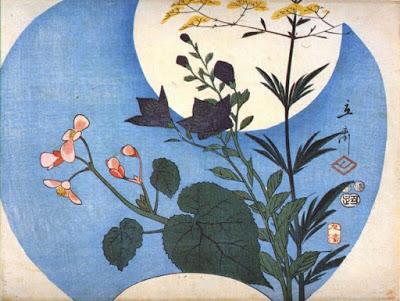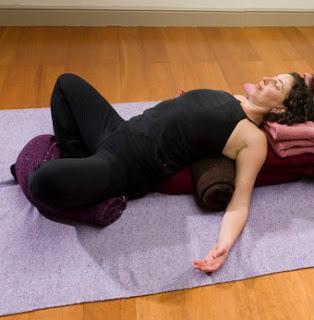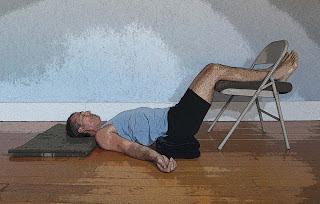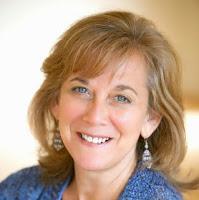
Autumn Flowers in Front of a Full Moon by Hiroshige
Menopause showed up inconveniently in my life when I was barely 40. My father-in-law was dying from ALS. My youngest was in the throes of adolescent rebellion. I had just opened my second studio site and my marriage was on shaky ground. Hot flashes (24/7 power surges really), insomnia and mental fog added kerosene to an already combustible mix of life challenges.While I had always been a strong asana practitioner, during this period I often felt like a gerbil spinning on the wheel to nowhere as I would rotate through my posture sequence. I encountered aches in my hips, knees, and shoulders that I had never experienced before. Sometimes I would just curl up in Child’s pose, exhausted from very little effort. Stripped of the stamina that I had come to rely upon, I was afraid that I would never recover from this malaise. Fortunately for me, my teacher at the time was able to put my experience into perspective. According to the Krischnamacharya lineage, yogis viewed life as a series of three stages that we move through. They counseled that practice needs to adapt as the practitioner ages to meet the needs of the current stage. (See Yoga for the Three Stages of Life, by Srivatsa Ramaswami for in-depth information.)In our youth, the Sunrise Stage, the focus is on developmental challenge: more physically demanding practices that support the maturation of a healthy body and discipline of mind—think Sun Salutations, arm balances, backbends, and strong standing pose sequences. For the middle years, the Midday Stage, the golden word for practice is rksana (pronounced rakshana). Rksana means protection. The wise yogis understood that we have many obligations pulling on us, challenging our time and energy during our middle years—children, aging parents, and mortgages to name just a few. Our practices therefore need to stabilize and nourish rather than be yet another depleting demand we impose upon ourselves. Gentle asana, pranayama, restorative poses, and yoga nidra, are invaluable tools for sustaining our physiologic and mental stability. These offer critical support to enable us to meet the complex needs of our family and community and return us to our own center of gravity.The Sunset Stage is the stage of later life, when we’re retired, and the focus traditionally was more towards God and the next life. Meditation and prayer are considered the primary practices at this stage. I realized via this teaching that it was my mind that kept pushing me to compete with my younger self. When I listened to my body, the message was very clear. Pranayama and restorative practices were welcomed like a soothing balm. Asanas that emphasized stability rather than flexibility and stillness over movement were more grounding. So when I was asked in 2003 to create a protocol for an NIH-funded study addressing hot flashes in menopause, I wove together practices that incorporated the wisdom of rksana and all I learned about what is particularly beneficial at this time of life. Women from all over the country took part in this study, which utilized gentle asana to stabilize the spine, shoulder girdle, and hips, pranayama to cool and calm the mind, restorative poses to provide deep nourishment, and yoga nidra to aid in relaxation and sleep. Feedback from participants was extremely positive. There was significant increase in nightly sleep. And many of the women expressed a feeling of improved overall comfort with their changing bodies, embracing the need to do less without feeling like they were less.It’s important for all of us to reassess our practices from time to time, to notice our attachment/beliefs regarding why we “have to” practice in a particular way. A deeper line of inquiry might be: How is my practice serving me right now? What is needed? Challenge or support? Effort or ease? More or less? Our lives aren’t static; parinama (change) is inevitable (Yoga Sutra 1:15). So why would our yoga practice remain static amidst the flurry of life? So with a nod to rksana, I encourage you to weave in more of the inner practices like pranayama, mantra, meditation and nidra into your practice to offer additional nourishment for your mind and spirit, and allow your busy body to rest. There are many such practices that you may find beneficial. Here are a few that have been powerful for me. PranayamaSitali/Sitkari (Cooling Breath): To inhale, curl your tongue like a straw (if you have the genes to do so) or roll the tip of your tongue to the back of your upper teeth, and suck your breath in through your mouth. To exhale, close your lips, rest your rolled tongue to your upper palette and exhale through your nose. Repeat several times to cool your system down. Great ER remedy if you feel a hot flash coming on! Moon Breath: For this practice, you breathe in through your left nostril and out through your right nostril. You can use your hand to alternate sealing your right and left nostrils and create a channel on the opposite side. Or you can work with this pranayama virtually by visualizing the flow of your breath continuously from left to right. This pranayama practice is very focusing for your mind as well as engaging the ida (moon/feminine) nadi and your parasympathetic nervous system (Relaxation Response).Try either of these pranayamas with a silent mantra of “So-Hum,” “Om shanti,” or “Om namaha” (“Letting go and letting be”) on each exhalation.AsanaIn general, work more slowly in your asana practice and use props for support. Balance strength work with stretching, taking care to avoid over-stretching, particularly around your hips, shoulders, knees, and sacroiliac joints. For restorative practice, I particularly recommend Supta Baddha Konasana (see Reclined Cobbler's Pose) and Viparita Karani with legs on a chair (see Featured Pose: Easy Inverted Pose), both pictured below.

Supta Baddha Konasana by Toni Gauthi

Viparita Karani, hips on a bolster or folded blankets,
legs on a chair instead of up the wall
Yoga nidra is a guided meditation that progressively releases tension in the body and mind, and has been proven effective at addressing anxiety, chronic pain, and sleep disorders. Regular practice will allow your body to ease into a deep relaxed and restorative state, cool excess heat, and create balance.Not sure where to start? I have made two CDs that you might enjoy, both of which are available for purchase.Cooling Nidras for Body and Mind: Guided Relaxation for Women of a Certain Age by Robin Rothenberg, music by Nancy Rumbel. Specifically created for the National Institutes of Health funded study aimed at managing hot flashes in menopausal women, these two guided relaxations includes evocative imagery of river water and gentle breezes induce a state of cool calm. Two 20-minute practices.Soothing the Spirit: Yoga Nidra to Reduce Anxiety by Robin Rothenberg, music by Nancy Rumbel. This guided relaxation was created to offer refuge to those with overactive minds that spin on the worry cycle. The imagery and evocative music induce a state of calm wellbeing, teaching you how to redirect your mind and free your spirit.


